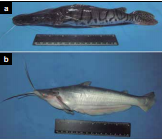Range of catfish of the Pimelodidae family in the Manamo stream and a flood lagoon
Abstract
The Siluriformes order is one of the most important worldwide, not only because of the large number of species that make it up, but also because of its wide distribution in various aquatic environments, especially in the continental sector (Burgess, 1989). Within this order are the species of the Pime lodidae family, which are exclusively sweet-tailed, and which, due to their high number, constitute the second best represented family in the South American continent; In addition, it is the most important from a commercial point of view, considering its high market price and that many of its members reach large sizes and weights, some around 2.5 meters and 150 kilograms (Barthem and Goulding , 1997). In Venezuela, pimelodids are represented by 105 species included in 40 genera (Lasso et al., 2004), distributed in all the country's basins and from an economic point of view, they constitute one of the most important fishery resources (Mago-Leccia et al., 1986).
The species of the Pimelodidae family are characterized by having a smooth body without scales or bony plates, the dorsal and pectoral fins have strong and sharp spines; the adipose fin is always present and developed. They have well-developed chin and maxillary barbels. Most of the species of this family are of nocturnal or twilight activity, they inhabit the bottoms of rivers with turbid waters and some of their species carry out migrations for food and reproductive purposes. The main objective of this research was to know the distribution area of the fish belonging to the Pimelodidae family present in the Manamo channel, one of the main effluents of the Orinoco river delta.
References
Burgess, W. 1989. A preliminary survey of Siluriformes. Atlas of Freswater and Marine Catfish. T.F.H. Publications, Inc. Neptune City, New Jersey. 782 p.
Canales, H. 1985. La cobertura vegetal y el potencial forestal del Territorio Federal Delta Amacuro (Sector norte del río Orinoco). Informe técnico, M.A.R.N.R. División del Ambiente. Sección de Vegetación. Caracas. Sin paginar.
Castillo, O. 1988. Aspectos bioecológicos sobre los peces comerciales del bajo llano con énfasis en los bagres (Orden Siluriformes). Tesis de maestría, Universidad Central de Venezuela, Caracas. 114 p.
Lasso, C. y P. Sánchez-Duarte. 2011. Los peces del delta del Orinoco. Diversidad, bioecología, uso y conservación, Fundación La Salle de Ciencias Naturales y Chevron C.A, Venezuela. Caracas. 500 p.
Lasso, C., O. Lasso-Alcalá, C. Pombo y M. Smith. 2004. Ictiofauna de las aguas estuarinas del delta del río Orinoco (caños Pedernales, Mánamo y Manamito) y golfo de Paria (río Guanipa): diversidad, distribución, amenazas y criterios para su conservación. 70-89 pp.
Lasso, C., P. Sánchez-Duarte, O. Lasso-Alcalá, R. Martín, H. Samudio, K. González-Oropeza, J. HernándezAcevedo y L. Mesa. Lista de los peces del delta del río Orinoco, Venezuela. Biota Colombiana, Vol. 10, núm. 1-2, 2009. 123-148 pp.
Lundberg, J. and M. Littmann. 2003. Pimelodidae (Longwhiskered catfishes). 432-446 pp. In: Reis, R; Kullander, S. and C. Ferraris Jr. (eds.) Checklist of the freshwater fishes of South and Central America. Porto Alegre. EDIPUCRS. Brasil.
Mago-leccia, F., P. Nass, y O. Castillo. 1986. Larvas, juveniles y adultos de bagres de la familia Pimelodidae (Teleostei, Siluriformes) de Venezuela. CONICIT Proyecto S1-1500, Informe final. Caracas. 168 p.
Novoa. 1982. Los recursos pesqueros del río Orinoco y su explotación. Corporación Venezolana de Guayana. Caracas. 386 p.


